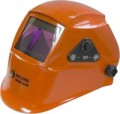Turn-on time
The turn-on time of the filter in the chameleon mask (see "Type"), in other words, the time between striking the arc and darkening the filter to the operating level.
From a safety point of view, the turn-on time should be as short as possible: the faster the "chameleon" works, the less bright light from the arc enters the welder's eyes. On the other hand, reducing the reaction time affects the cost of the product. So for relatively small volumes of work, it is quite acceptable to use relatively “slow” masks — for
100 μs or more(especially since even in the simplest models, the reaction time does not exceed 1200 μs, while theoretically the maximum allowable value is 2000 μs). But for more serious use, you should pay attention to more "fast" options; nowadays, you can find masks with response times
from 75 to 100 µs,
from 50 to 75 µs, and even
less than 50 µs.
Filter viewing area (WxH)
The size of the transparent part of the light filter — the "working window", the area through which the welder sees the place of work. A larger working window provides ease of use and a wide field of view, but it significantly affects the cost of the mask and somewhat reduces the strength of the light filter.
Filter cartridge dimensions (WxH)
The overall dimensions of the light filter for which the mask is designed, taking into account the working window, protrusions for mounting, batteries, sensors and other structural elements. This indicator is especially important for models that are not equipped with light filters: without knowing the size, it is very difficult to choose the right cartridge. In other cases, data on the size of the cartridge is needed mainly when looking for a replacement for a failed colour filter.
Design features
— Backlight. Illumination system built right into the mask. This feature is very convenient when working in low light conditions: the backlight does not take up the hands (unlike hand-held flashlights) and does not create problems with wearing a mask (unlike headlamps), while the beam of light is always directed to where the welder's head is turned. On the other hand, such a system requires its own power supply. Therefore, it is used only in "chameleons", while the operation of the backlight additionally consumes battery power.

